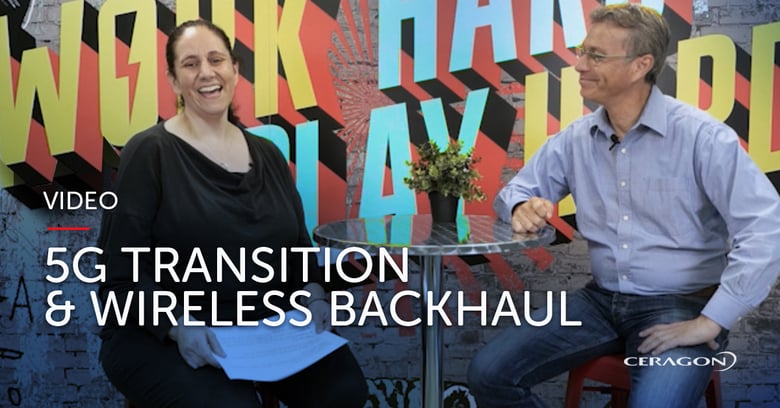What role is wireless backhaul set to play in the transition to 5G? Well, according to a recent report conducted by GSMA, titled ‘Wireless Backhaul Evolution - Delivering next-generation connectivity’, it is said that despite the growing importance of fiber, wireless backhaul is set to play a central role in the transition to 5G and that a sizable backhaul evolution is required to accommodate for the growing traffic and new network capabilities.
This report concurs with Ceragon's assessment that higher capacity backhaul bands will be vital to meeting 5G traffic demands. Watch the video to learn more:
Full interview transcript:
Hello and welcome to the 'Backhaul Lounge'. I'm Tanya Solomon and I'm joined today by Oz Zimerman, EVP Marketing and Business Development at Ceragon.
Hello.
Hi. And today we're going to discuss the role wireless backhaul is set to play in the transition to 5G. Welcome, Oz. So in the recent GSMA report titled "Wireless Backhaul Evolution: Delivering Next-Generation Connectivity", they say the transition to 5G will be the sizable backhaul evolution to accommodate growing traffic and new network capabilities, and that despite the growing importance of fiber, wireless backhaul is set to play a central role in these developments. Oz, can you elaborate on why that is?
Actually, GSMA's analysis is very much in line with Ceragon's analysis. Today, we have around four
hundred million subscribers of 5G, right in 2021, first quarter. We expect to have 10x more mobile subscribers by 2027, so within five to six years. Which means 4 billion subscribers of 5G. Now what does it mean? It means that the networks exponentially have more traffic.
OK, now more traffic, what does it mean? It means that in order to support this traffic, the mobile networks will have to go through significant densification. And for densification, you need a leapfrog for the backhaul. Now, leapfrog for the backhaul could be fiber and could be wireless backhaul. Fiber is a great way to connect. However, it's not accessible and not affordable in many of the sites. And if you want to do it very quickly...
Wireless is the way to go.
Wireless is the only way to go.
Oz, the report also says, that higher capacity backhaul bands will be vital to meeting 5G traffic demands. What does that mean? And can you share some of the solutions and developments that Ceragon is working on to address this?
Sure, sure. So current backhaul bands will still play an important part in the network. But in the 5G era, in order for them to be relevant, they need a much wider bands. Wider bands, Ceragon today already offers with the IP-50 224 megahertz channels with the existing bands. So that's the first step.
Now new backhaul bands are needed to support the evolving network requirement
and the growing traffic. And with the W-band and D-band that are around the corner, we'll be able to offer to support channels size of two gigahertz. And we Ceragon are already in the very advanced stages of developing our W-band and D-band solutions, based on our own system on a chip, the Neptune, which is the digital part, as well as developing the RF chips to support the new bands. Now, beyond the what we call "traditional" 5G, there is also the new trend of Open RAN, which is disaggregating the network in the 5G era. Now this is a new architecture which many service providers are approaching and are committed to it.
And with Ceragon's disaggregated wireless hauling, we fit exactly to the same concept of separating hardware from the software. This is also opening up a new domain for Ceragon, which is the fronthaul. Today, we already offer 20 gigabit per second with our existing offering with E-CPRI, but with a new development based on Neptune, we will be able to offer up to 100 gigabit per second in the fronthaul.
Wow. Well, that's great news from Ceragon. And I want to thank you for sharing that information with us. Thank you for tuning in to the Backhaul Lounge. We invite you if you'd like to learn more to visit us on Ceragon.com, follow us on LinkedIn or subscribe to our blog. And we'll see you in the next episode. Thank you.
Learn more about flexible and open architectures for 5G


